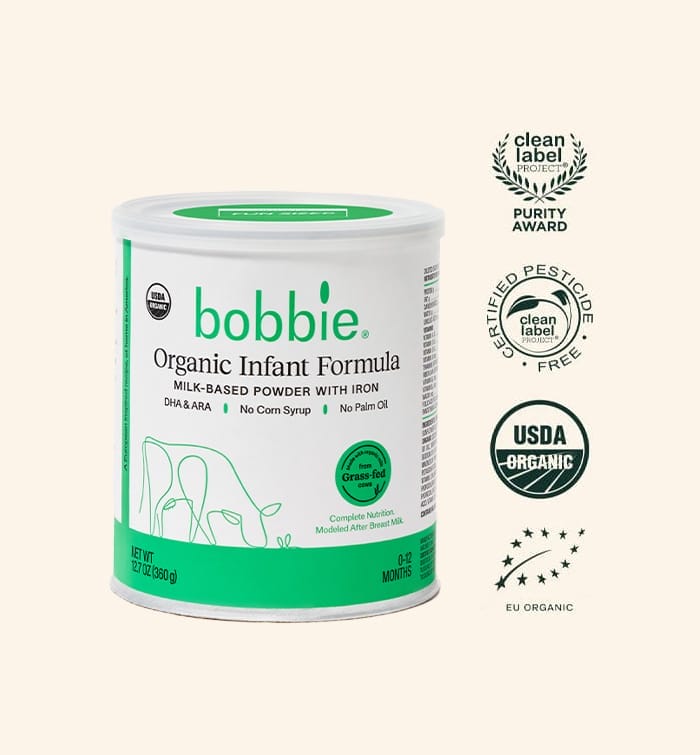We are proud to say that these posts are not sponsored. Our editorial team of Bobbie moms and writers personally select each featured product. If you buy something through our links, we may earn an affiliate commission, at no cost to you.
Let’s talk about infant feeding… and the poop that comes with it. You can’t have one without the other, right? Understandably, parents can have a lot of questions about their baby’s poop and often wonder what is normal and what isn’t. Since there are so many kinds of normal poop and quite a few kinds of abnormal poop, we need some more information to be able to answer these questions.
Ready to dive in? Then, let’s go!
- What’s the difference between breast milk and baby formula?
- The scoop on baby poop
- Newborn poop, what is meconium?
- What does breast milk poop look like?
- What does formula fed baby poop look like?
- Do formula fed babies poop less than breastfed babies?
- Why does baby poop vary by color?
- What’s the ideal consistency of baby poop?
- What kind of baby poop is concerning?
What’s the difference between breast milk and baby formula?
First, let’s talk about the different options for feeding your baby. Here are the main components of breast milk and infant formula:1,2
What is breast milk made of?
- Carbohydrates
- Fats
- Proteins
- Antibodies
- Hormones
- Enzymes
- Vitamins and minerals
What is infant formula made of?
Infant formula is used both as a supplement to breast milk and instead of breast milk for infant feeding. All formula that is made and sold in the US is regulated by the Food and Drug Administration (FDA) and meets their standards for ingredients.3
- Carbohydrates
- Fats
- Proteins (often milk-based)
- Iron and other vitamins and minerals

Shop Bobbie Organic Infant Formula
Bobbie Organic Infant Formula is a USDA Organic, EU-style infant formula that meets all FDA requirements. It is a complete nutrition milk-based powder modeled after breast milk and is easy on tummies. It is non-GMO and doesn't have corn syrup, palm oil, or maltodextrin. Learn more about Bobbie.
The scoop on baby poop
Now that we know what goes into breast milk and infant formula, let’s take a look at what comes out!
Newborn poop, what is meconium?
Whether your baby will be fed breast milk or formula, their poop is going to look the same in the first few days of life because they haven’t had much of either yet. Newborn poop is initially black and tarry- this is called meconium. Babies should pass meconium at least once in the first 24 hours of life.
What does breast milk poop look like?
After a few days, breast milk poop often appears more yellow and seedy. These usually happen around 4 times per day, often after a feeding.
By the time your baby is a month old, they may be pooping less often than 4 times per day and may even go a few days between poops.4
What does formula fed baby poop look like?
The poop of formula-fed babies is usually more tan or brown and less yellow than breastfed babies. Formula-fed baby poop is also usually a bit thicker than breastfed baby poop and is not typically seedy in appearance.5
We spoke with Tiffani Ghere, RD, certified lactation educator, pediatric nutrition specialist and Bobbie Medical Advisor. She notes, “Poops from formula-fed babies are often somewhat different in their appearance. They often have a pastier consistency and can range from green to brown to yellow. All are considered normal.”
Do formula fed babies poop less than breastfed babies?
“Formula-fed babies are reported to poop less frequently than breastfed babies,” says Ghere, “but by one month of age, many babies are pooping less frequently, regardless of what they are fed. As long as the baby can easily poop without straining and the poop is soft, the frequency of several times a day to every 3-4 days is within the normal range.”
Why does baby poop vary by color?
There is some variety to what is considered a normal color for baby poop, but a few colors are cause for concern. Let’s break down what’s ok and what isn’t.
Green infant poop
Green poop can be surprising the first time you see it, but this is most often normal. If your baby is old enough to be eating solid foods, there are certain foods that can cause this. Babies who take iron can also have green poop. Breast-fed babies who switch breasts often may also have green, frothy poop. Staying on one breast until it’s drained can help to fix this and make sure your baby is getting all the full-fat milk they need.5
It’s important to know that green poop can also happen when your baby has a stomach virus, so if this is a new change and occurring with vomiting, poor eating, fever, or other signs of being sick, be sure to call their healthcare provider.5
Yellow or brown infant poop
As you may have guessed, brown and yellow are pretty normal colors for baby poop.5
Black or red infant poop
Black and red poop are causes for concern because this often means that a baby has blood in their poop. There are a number of reasons babies can have blood in their poop, and some are more dangerous than others. If you notice that your baby has black or red poop, it’s best to seek medical attention.5
White infant poop
White poop doesn’t occur very often, but when it does it’s a reason to call your baby’s healthcare provider. White poop can indicate an issue with a baby’s liver, so don’t ignore this color poop if you see it.5
What’s the ideal consistency of baby poop?
We’ve talked color, now let’s talk about hard and soft baby poop.
Watery baby poop
Baby poop is often on the softer side, but a sudden change to watery could be a sign of an infection or other problem. Take note of whether your baby is having any other symptoms and see below about when to call your baby’s healthcare provider.
Hard baby poop
Hard poop that is difficult for your baby to pass can be caused by constipation. This is a common problem in babies and children and it can have different solutions depending on your baby’s age and if you can identify what’s causing it. Sometimes constipation can indicate a serious medical problem, so it’s important to talk with your baby’s healthcare provider if you notice this issue.
What kind of baby poop is concerning?
Hopefully you now understand that there are lots of variations of normal for baby poop. Some babies poop more often than others, some poop is softer, and there are multiple normal colors for poop. So when should you seek medical attention about your baby’s poop? Here are a few reasons for concern:
- Black, red, or white poop
- Pain with pooping or while trying to poop
- A change in poop with other signs of infection (vomiting, fever, poor appetite, fussy)
- Not gaining enough weight
- Not making a normal number of wet diapers
As always, you know your baby best, so if something new is happening that isn’t on this list and you feel worried, reach out to your baby’s healthcare provider.
Before you know it, it’ll be time for the next hurdle in the pooping journey- potty training!

Shop Bobbie Organic Infant Formula
Bobbie Organic Infant Formula is a USDA Organic, EU-style infant formula that meets all FDA requirements. It is a complete nutrition milk-based powder modeled after breast milk and is easy on tummies. It is non-GMO and doesn't have corn syrup, palm oil, or maltodextrin. Learn more about Bobbie.
Sources:
1- Human milk composition: Nutrients and bioactive factors | Pediatric Clinics of North America
2- Infant formula | American Family Physician
3- Questions & answers for consumers concerning infant formula | Food and Drug Administration
4- Breastfeeding FAQs: Getting started | Nemours Kids Health
5- The color of baby poop and what it means | Cleveland Clinic

